When I came to Japan this time round, I didn't really know what are the special highlights during the summer season. In spring, there are the sakuras. In autumn, there are the red leaves. It is only 2 weeks after I arrived, and after a few research, I came to realise that summer is famous for its fireworks festivals nation-wide.
Thus a month before, I drew up a plan to visit the few fireworks festivals in the area. The first was Nagoya Port fireworks during the Marine Day, but I cancel the plan as I was pretty tired after the trip to Hiroshima.
The second one is to Gifu Nagara-kawa (Nagara river) Fireworks Festival. Heard this is Japan's top 3 fireworks festival with 30,000 fireworks to be released. This posting is about the Nagara-kawa Fireworks Festival. The third is to be in Nagoya Yada-river on the 2nd August. But I decide to skip it as the weather is just too hot and after seeing the best (Gifu Fireworks), the rest will be so-so.
This trip is somewhat special as I will be asking a few more colleagues to join me in the festival.
In the first photo we have Katayama-san, Fujisawa-san and Shin-san (from Korea).

And in the second photo we have me (from Singapore), Lin-chan (from Taiwan) and Park-san (from Korea).
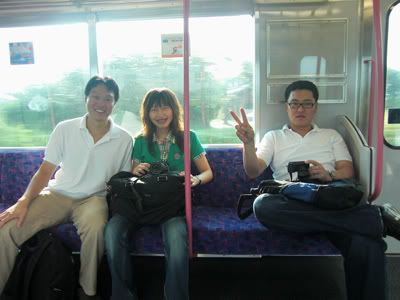
We left our lodging at 4pm. We split into 3 groups, with one leaving from Tokadai, another leaving from Komaki and the third leaving from Ajioka. But I plan to meet everyone in the train. From Komaki-hara, the Tokadai group will be taking the 4.38pm train and we should arrive at our destination at 5.40pm. From Gifu train station, we took a bus to the Nagara-kawa fireworks area. There is a long queue of people going there, though it cost 200Yen per person. Notice a lot of people are dressed in Yukata.
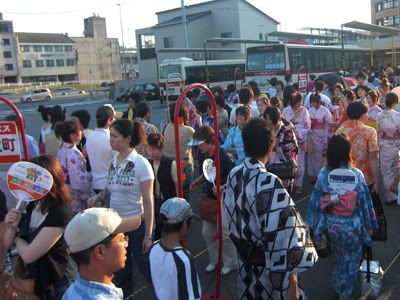
When we arrived at our destination at 6.30pm, a large crowd has already gathered. Occasional fireworks were set off.
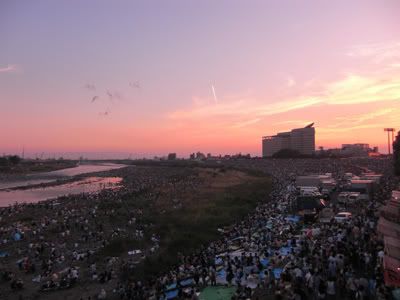
Here is one of the multi-coloured fireworks set off at 6.55pm. There are lots of stalls in the area selling food and drinks.

The first special fireworks went off at 6.55pm.
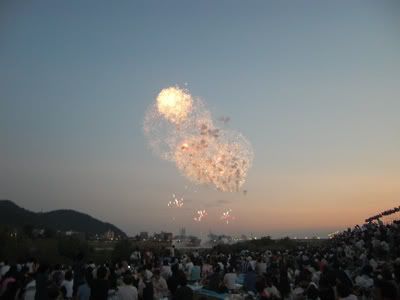
And it continue throughout the night till 8.45pm.
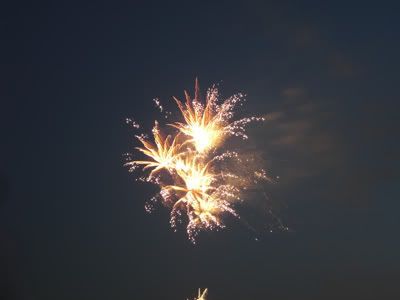 The following few photos are taken by lin-chan.
The following few photos are taken by lin-chan.

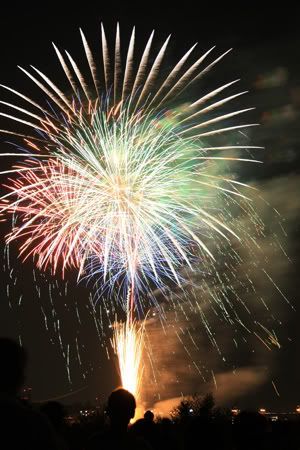
I have recorded a few videos of the fireworks for visitors to have a glimpse into it.
The Gifu fireworks festival have presenters from all over Japan - the different prefectures. It is different from the traditional fireworks we see in Singapore or the less popular fireworks festivals elsewhere in Japan, as the fireworks being released here follow a theme or pattern.
The variety is greater.
We start to leave around 8.30pm due to the huge crowd of people. An estimated 300,000 attended this festival. We got back to our rooms at 11.30pm.
The visit to Hiroshima and Miyajima is a trip which I have planned a month before. The aspiration of visiting these two places is somewhat similar to the Koya-san trip last November. It is also the longest distance trip I will be taking from my place of accommodation to my travel destination. Hiroshima is the last of the top 10 most visited destinations and Miyajima is also the last of the 'best of the best' sight in the main Japan country (excluding the southern islands).
With Hiroshima and Miyajima, I can say I have completed most of Japan main and important sights that a normal traveller will visit in his lifetime.
When I travel, I will normally take buses as the cost of travelling by bus is half that of bullet train. The overnight bus reservation has been made a month in advanced, and the payment completed 3 days before departure. Everything is done via the internet so I do not have to make a trip down to the bus station.
Another special significance about this trip is that I will be travelling entirely alone. So I will be meeting people along the way in my travels.
Getting to Hiroshima
I departed from my accommodations at 9.10pm to catch the 9.25pm bus to Kasugai station. From there is a direct train to Nagoya. It is through this trip that I found out travelling by this route is cheaper than the Nagoya direct bus. It cost 620Yen instead of the normal 680Yen. I got to the station fairly early at 10.20pm. That leaves me with 30 minutes or so to wander around the station.
The bus arrived at 10.50pm. It is a double decker express bus. Total bus journey time is scheduled to be 8 hours and 30mins (2 hours more than the flight time from Singapore to Nagoya).

I am seated on the second floor. It came as a pleasant surprise that there are 3 seats in a row. That will give everyone ample space to rest the night. The air-conditioning can be switch off completely so I will not be afraid of extreme cold in the morning. Thankfully, the lights are also off half an hour into the journey so everyone can have a good rest. The seats can be reclined to almost 140 degrees. Blanket and slippers are also provided. The return bus ride cost 14,800Yen (S$200).
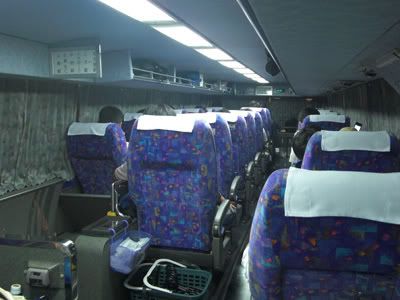
The bus stop 3 times along the way but I don't think anyone got down. I am too sleepy to notice anything. Starting from 6am, passengers started getting off the bus. It arrived at Hiroshima Bus Centre at 7.20am (10 minutes before scheduled time). I am quite surprised that this is not the last stop and I'm one of two passengers getting off here.
After a quick wash-up at the bus station, I am ready to explore Hiroshima and Miyajima.
Getting to Miyajima
The Hiroshima Bus Center is at the Sogo Centre which is somewhat in the middle of Hiroshima. The moment I leave the Sogo Centre, I already know my bearings and where I am to proceed.
The plan is to take the Hiroden (Hiroshima Tram) from Kamiya-West stop to Miyajima-guchi. The journey will take around 50mins and the tram arrives on average every 10minutes. I have done my research online via the japanese Hiroden website.
Here are photos of the tram against the Sogo Centre as the background.
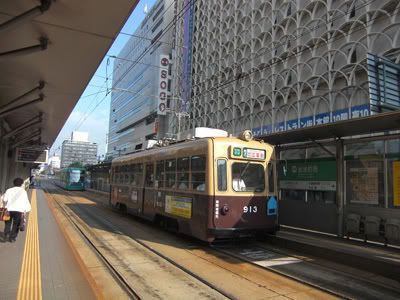
There are both new and old trams plying along the main Hiroshima roads. Let's take a sneak peek into the driver seat and how passengers make payment. Seriously I do not know how they keep track on which station the passengers board the tram. When I and another Japanese traveller board the number 2 tram bound for Miyajima, we were momentarily puzzled that there are no boarding tickets at the entrance. But I know I just have to pay the maximum fare of 270Yen when I reach my destination, so that is not a problem.
Secondly, I was initially planning to get the day free pass to travel to Miyajima, but from the website, it mention the pass can only be purchased from hotels and some bus stations. I saw an advertisement from the tram saying that the free pass can be purchased the tram conductor. There are 3 types of passes: 1) 1 day tram pass[600Yen] 2) 1 day ferry pass[840Yen] 3) 2 day free pass[2000Yen].
I queried the conductor who is standing at the end of the tram on the travel pass and she replied that it can be purchased from her. I just paid for the 2 day free pass. For the trip, I was initially planning to take a cable car up and walk my way down from Mt Misen.
In the end, I came to realise that the 2 day free pass is my best investment ever in Hiroshima.

From here, my adventure to Miyajima will be continued in a separate post. I have limited the number of photos that I should upload for each posting to 40max. And I decide to separate Hiroshima travel and Miyajima travel. So please click on the link below for the Miyajima travel. After reading through the Miyajima travel, please continue below.
Miyajima [19/07]
I will be spending a night in Hiroshima. As such I made reservations about a month in advance too. I did not actually search extensively for a place to stay. Just opted for one whose price is reasonable and the rooms are pleasant. After reading through a few reviews, I settled for J-Hoppers Hiroshima Hostel. It is less than 5mins walking distance from the Hiroshima Tram stop (Dobashi) and it runs along the line from Miyajima. Here is the J-Hoppers Hiroshima Hostel.
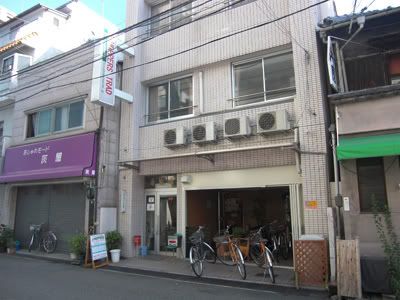
I arrived at the hostel around 9.30pm in the evening. The staff is extremely friendly. I believe they should have no problem conversing with the guests in English, but I choose to speak to them in Japanese. Managed to maintain an entire conversation in Japanese with them from start till the time I checked out.
The hostel is also pleasantly clean. Here is how one of the dormitory room looks like. It can accommodate 8 people. Most of the other guests are not around when I arrived but I am the last to check-in. After a quick washup, I turn off the lights at 10.15pm and have an early rest. It has been a long day: 9 hours of bus ride follow by 14 hours of outdoor walking, I decide to turn in early as I will be leaving the dormitory at 8am tomorrow.
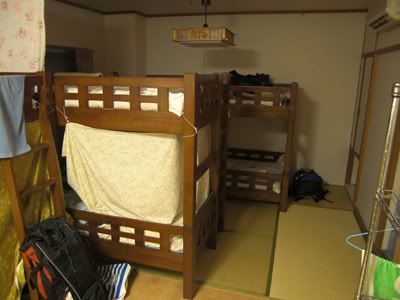
I woke up at 7.30am the next morning. After a quick wash-up, I check-out from the hostel. At the waiting area, I met a Malaysian who is travelling with his family of 4. We have a 10mins chat. He came from Kyushu and is currently studying in Japan.
As I am in a hurry, I have to bid farewell to them.
Peace Park
The Peace Park is only a 5mins walk from the hostel. There are many statues and memorials depicting the horrors of the atomic bomb. Hiroshima is the first city in the world where the atomic bomb has been detonated. It is also the city with the most number of a-bomb casualties. Below is the statue of the Mother and Child in the Storm against the Fountain of Prayer and Peace Memorial Museum.
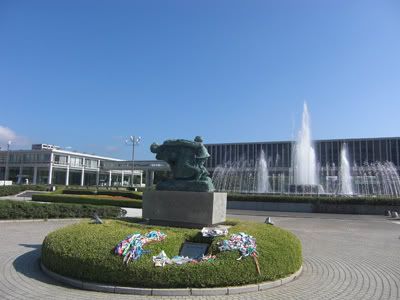
I arrived at the Peace Memorial Museum at 8.30am, which is just nice the opening time. The entrance fee is only 50Yen, with the optional audio guide of 300Yen. The first floor mention why the atomic bomb is dropped in Hiroshima - World War II. A miniature Hiroshima city showing the before and after the atomic bomb detonation is found at the centre of the museum. Hiroshima is noted for its important military location, as such, it is the chosen site for the a-bomb. The city had never been hit by convention bombs as the Allies wanted to measure the effects of the a-bomb.

Unlike conventional bombs, the most deadly aspect of the atomic bomb is radiation. There are many scenes showing the destructive power of the atomic bomb on human lives in the museum. Stories of how individuals lived through their last days after the detonation were also being told.
At the second floor of the memorial museum, there is a perfect view of the main sights in the peace memorial park. Right in front is the Cenotaph for the Atomic Bomb Victims. In the distance we have the Atomic Bomb Dome.
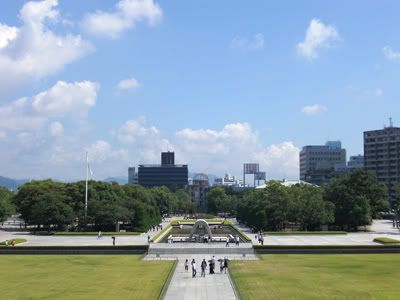
When I walked to the Cenotaph, I noticed a ceremony is about to take place. They are actually monks from a Shingon sect holding a memorial ceremony for the a-bomb victims.

This is the Children's Peace Monument. The statue of a girl holding a paper crane is at the top. There is actually a story behind this. It is about the child Sadako who was diagnosed with leukemia (the atomic bomb disease). There is a japanese legend that say anyone who folded 1000 paper cranes could be granted a wish. She started folding the paper cranes but passed away before she could complete it. Her classmates continued for her and eventually a monument is built dedicated to Sadako and the children killed by the a-bomb.
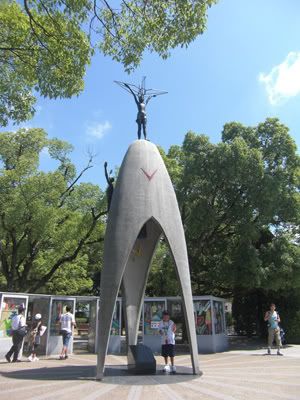
At the eastern end of the park is the memorial hall for the a-bomb victims.
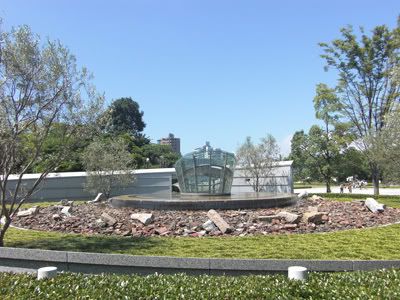
The main hall.
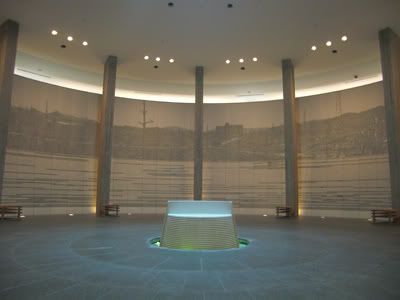
Across the river to the other end is the Atomic Bomb Dome. It was originally the Hiroshima Commerical Exhibition building. The atomic bomb exploded slightly above it (600metres). The epicentre is actually at the bridge next to it. Almost all the buildings in Hiroshima were flattened except for this prominent one.
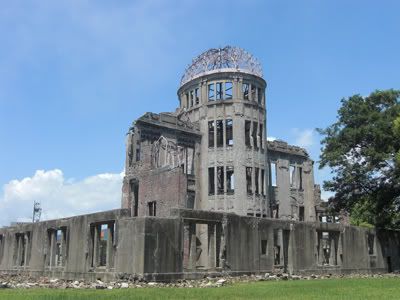
Here is me with the dome as the backdrop.
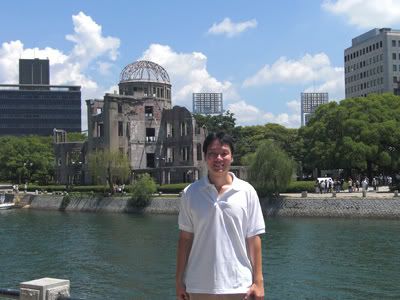
A lotus in the pond surrounding the Peace Bell.
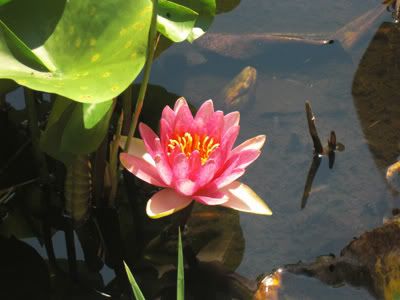
I walked across from the Peace Park to the Hiroshima Stadium area. Standing in the middle of the street, I took a quick shot of Hiroshima city on a sunday afternoon.
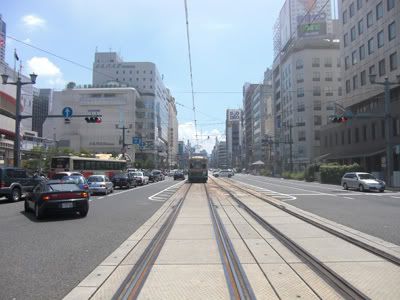
Baseball Match
There is something happening at the Hiroshima Stadium. When I was walking around the Peace Park, I already heard the cheers and drums coming from the stadium. It will be nice to watch a game if there are tickets available. At the Peace Museum, it is said the people of Hiroshima turn to baseball for entertainment to get over the horrors of war and the atomic bomb. It is quite depressing reading through the effects of the atomic bombs and the victims, so a baseball game now will be just great.
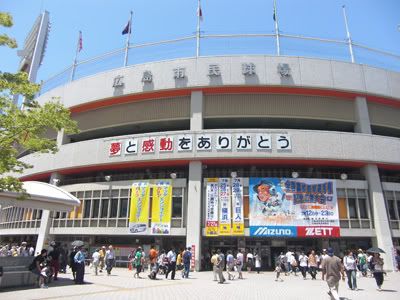
Tickets are actually being sold at the counter for 500Yen. There are people queuing for it, so I just joined in immediately. Yea! I got the tickets. I noticed the gate is being manned by students. Past the entrance, a game is ongoing.
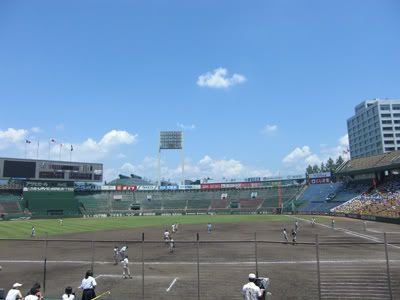
It is actually a high school baseball competition between Miyajima Technical and Hiroshima Technical. They are all-boys school. I started watching the game at 11.20am. Was initially planning to hang around for 1 hour, but the game is just fascinating, in the end I stayed until 1pm. It was pretty hot, so most of the crowds were hiding under the stadium shade. The match started at 10am and was scheduled to end at 4pm. The morning competition between these two team ended at 1pm.
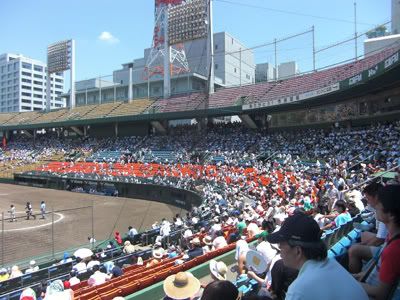
I have video capture the competition. The best part of the match is watching the people supporting the team. The schools have their own cheerleading team. I really like their cheerleading rhythm. I think the cheerleading team had the most fun, they were dancing around and cheering along. I spent most of the time watching the cheerleading team instead of the game.
The match ended with Hiroshima Technical winning the match 11-4. The two teams bow towards each other.
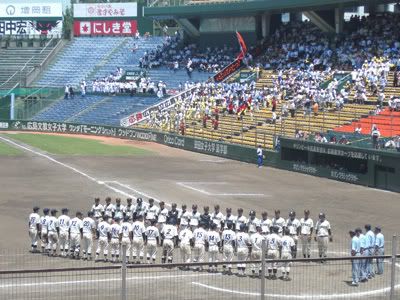
Around Hiroshima
After the match, I walked northwards towards the direction of Hiroshima castle. This castle has been rebuilt in the last century, so there is nothing special about it. I just took and photo and moved on.
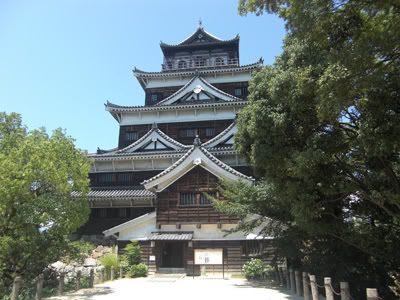
I walked to the Shukkeien Garden. As the day is pretty hot, I decided not to visit the garden. I turn southwards to the Memorial Cathedral for World Peace. The building looks quite intimidating and like all churches/cathedrals worldwide, they are the same and nothing unique. So I gave it a skip and went straight down to the Kanayama-cho tram line. From there I took the tram to the Hijiyama-shite tram stop. It is at this stop where the Hiroshima City Museum of Contemporary Art and the Manga Museum is located.
Here are some of the art pieces found outdoors.
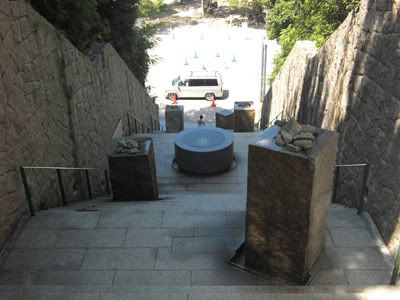
But the main highlight of this area is actually the Manga museum. There are lots of manga in there, and also lots of people. I can't take a photoshot indoor as there are people at every shelves. I hang around there reading through the comics for half an hour. The comics are all at the second floor of the building. It is not a large as I expected but has most of the main comics.
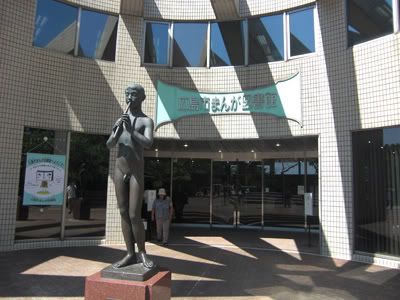
After the visit to the museum, I went back to the Peace Museum to catch the videos on the atomic bomb. The last airing of the videos are between 4pm till 5.20pm. The weather is awfully hot and I decide not to stay outdoors for long.
Once I have finished viewing the videos, I went to search for Okonomimura (Okonomiyagi village). Hiroshima is famous for its unique style of Okonomiyagi (Japanese Pizza) where noodles are used instead of the traditional vegetables/seafood/meat. The 2nd - 4th floor of Okonomimura has lots of Okonomiyagi shops. I just choose a shop at the 2nd floor where the lady looks very friendly. I tried to avoid sitting close to where they are preparing the okonomiyagi as I'm afraid the bbq scent might stain my shirt.
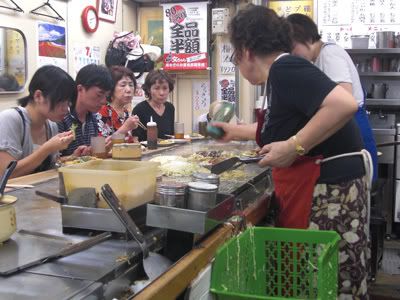
I went for the soba combi. Here I am savouring the Okonomiyagi. The shop lady is very friendly and helped me took a photo. You will also notice that I am RED. No, it is not caused by the radiation fallout from the bomb or the photos given a tinge of red, but by the intense sun. I have sunburnt!
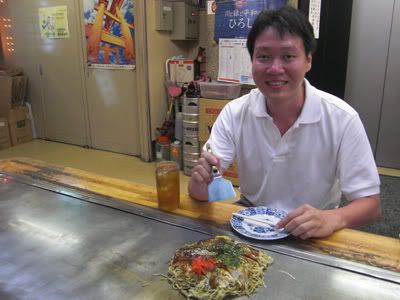
The temperature for the evening is 34 degrees! I am quite shocked by it, no wonder it seems awfully hot. I believe the afternoon temperature should be between 35-36 degrees.
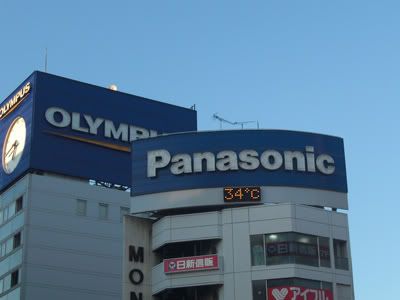
I went on down to Hiroshima station to check it out. There is nothing much around there. The area seems pretty quiet in the evening. So I went back to the shopping street around Hondori. I visited one of the bookshops and stumble upon this Japanese book by a writer who went to Beijing university for studies. It cost 650Yen only so I just bought it. It is my first attempt at reading Japanese book. Quite surprising, I understand it.
I went back to the peace park to capture the night scene there. Here is the a-bomb dome with its reflection against the river.
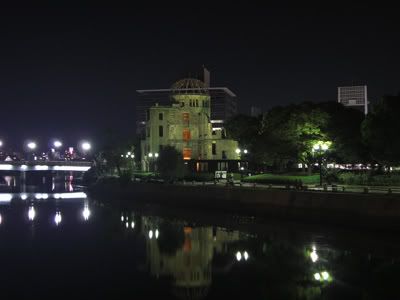 I got to the bus station at 9pm and just sat there waiting for the 10pm bus, reading the Japanese book along the way. I noticed some fellow passengers waiting for the bus were also equally red. This shows I am not the only one affected by the intense sun.
I got to the bus station at 9pm and just sat there waiting for the 10pm bus, reading the Japanese book along the way. I noticed some fellow passengers waiting for the bus were also equally red. This shows I am not the only one affected by the intense sun.
This post is actually linked to my Hiroshima (広島) trip. Please click the below link to find out how I got from Hiroshima city to Miyajima (宮島) ferry terminal.
Hiroshima [20/07]
Arriving in Miyajima island
I arrived at Miyajima-guchi tram terminal at 8.50am. The tram was packed with kids three quarter into the journey. Nevertheless, I managed to get off fast and hopped onto the ferry. There are two ferry companies serving the route to Miyajima island. The Matsudai and the JR. As I have bought the 2-day free pass, I can only use the Matsudai ferry. I did not know which is which initially, so I just walked to the ferry gate and hopped on the first ferry waiting there.
The ferry ride takes around 10mins. It provides passengers with a beautiful view of Miyajima island. There are 3 floors to the ferry. The 1st is for vehicles, the 2nd is an air-condition room and the 3rd is al fresco. I went straight to the 3rd. Here is a photo scene I took from there.
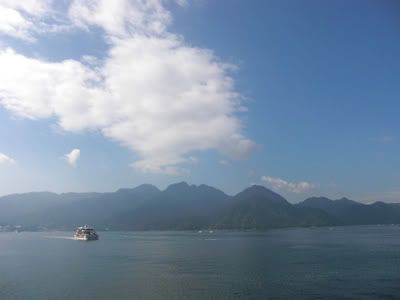
There is a Tourist Information Centre at the ferry terminal in Miyajima. I took the Misen (彌山) map and the highlight of the day - Kangensai Festival (管絃祭). After reading through the festival description, a change of plan has been decided. I will be at the Itsukushima Shrine (厳島神社) at 4pm to watch their portable shrine departure ceremony. When I was doing my research, I did not know where the shrine boats were departing from. Now everything became clear. I also plan to visit the Jinja in the morning as the high tide will be at 10am. The famous sight of Miyajima only happens during high tide.
Miyajima is also famous for its many deers like Nara. Here is a photo of the deers pushing down a bicycle and eating the maps. The owner of the bicycle is only next to it.
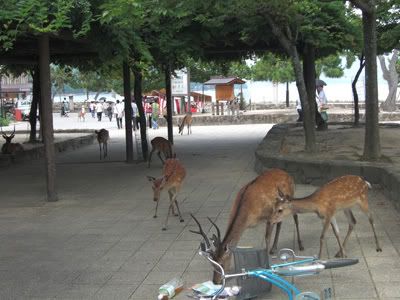
Itsukushima Shrine
The famous sight of Miyajima. It is high tide. You may ask why is the Torii gate in the middle of the sea. Well, in the past, visitors are forbidden on the island and the only way to the island is via the Itsukushima Shrine. The shrine design is also somewhat similar to that of a pier. Thus ships going to the island have to pass by this torii gate and straight to the jinja. They cannot land on the shores of the island. From this photo, the size of the torii gate may not be entirely known. In the subsequent photos below, you will see the actual size relative to the boats and people. It is really huge. That is why it is call otorii - big torii gate.

Here is Itsukushima Shrine. It cost 300Yen for the entrance. I can enter and leave anytime I like throughout the day. Here is a scene at high tide. To see it at low tide, please scroll down below and you can compare between the two photos.
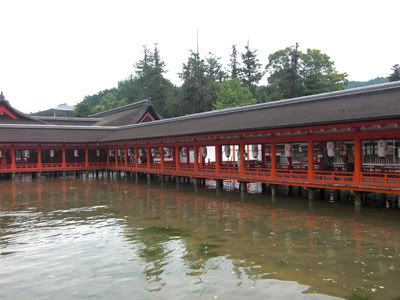
There are fewer visitors in the morning, thus I am able to capture the unique symmetric architecture.
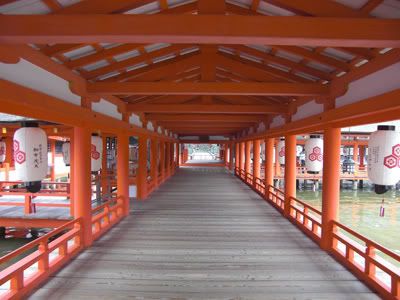
A curved bridge leading out. A tour guide leading a group of university students explain in Japanese that this bridge is unique in that there are no stairs. Oh ya!! I didn't actually notice that. Only find the shape to be fascinating.

The festival boats docked at the shrine. I heard from a lady who is saying in Japanese that the boats will depart at 10am; at the peak of the high tide. Hmm... That means it is best that I remain around to see the boats row out of the shrine. It will be quite an exciting scene.
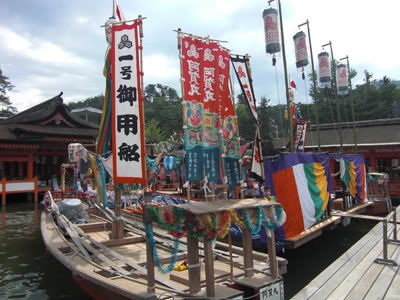
I have captured a video of the boats rowing out of the pier, with their drums beating.
The main festival boat passing through the torii gate. Notice how large the gate is. It can easily allow a full length boat to go through.
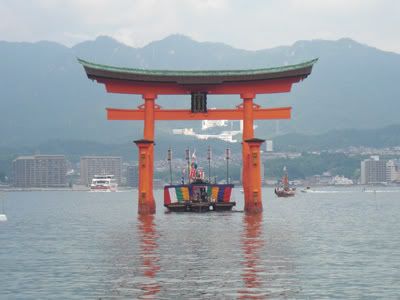
Daisho-in Temple
The Daisho-in (大聖院) temple is one of the recommended temples to visit in Miyajima island by several tourist guides. The aura surrounding the temple is just amazing! It has a very grandeur yet simple feel to it. Visitors to the temple will feel all their worries disappear and be at peace with the surroundings.
Here is the flight of stairs leading up to the main temple compound. Notice there are red leaves to the right, the scene is heavenly.
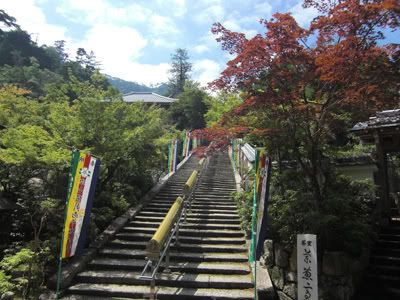
To the left of the entrance is a route where visitors can observe the 500 Arahants.
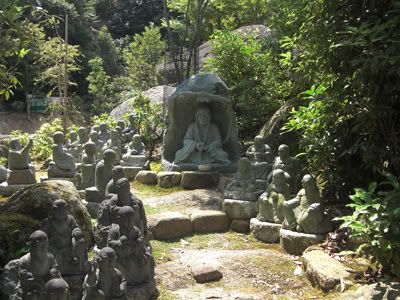
The route leads off to the middle of the flight of stairs. At the centre piece are prayer wheels where visitors can turn when they walk up or down the stairs.
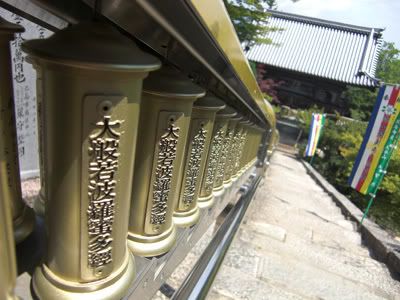
A representation of Kannon(観音) with the temple's pagoda at the background.

This temple belongs to the Shingon branch of Japanese Buddhism. In the main hall, I noticed the picture of His Holiness The 14th Dalai Lama. I saw many of His Holiness photos in there with the temple's abbot.
Another flight of stairs leading to the teaching hall.
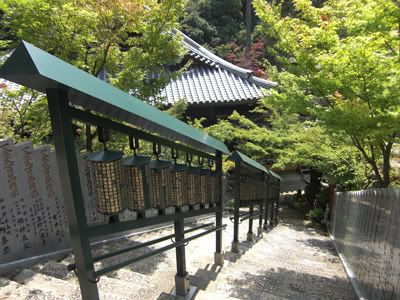
A hall with many lamps. This hall is located in a natural cave.
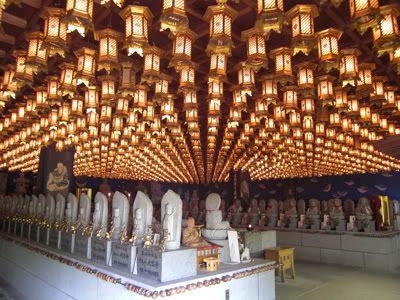
It is in this temple that I noticed a DVD video on Kukai, the founder of Shingon Buddhism. It cost 4,500Yen. As I am quite fascinated by Buddhist videos, I just bought it. Though I clarified with the temple staff that the DVD has absolutely no subtitles or any other language other than Japanese.
I refilled my 500ml tea bottle with the temple herbal tea. The weather is getting really hot and it is now 11am. The temple herbal tea will quench my thirst at the crucial moments when I am going up Mt Misen next.
Travelling to Mt Misen
I have a quick lunch of Udon at a simple hut on the way up to the cable car station. From there I took the ropeway up Mt Misen. There is firstly the ropeway leading to a height of 367m, from there I need to transit to a cablecar to the final stop of 430m.
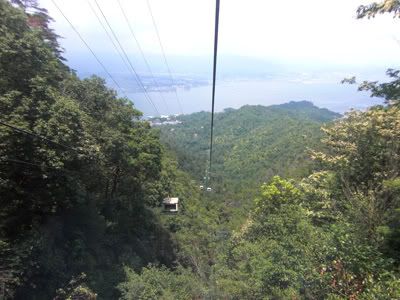
At the end of the cablecar ride, we are given a breathtaking view of the famous inner sea of Japan. It borders Shikoku and the main Japan island.
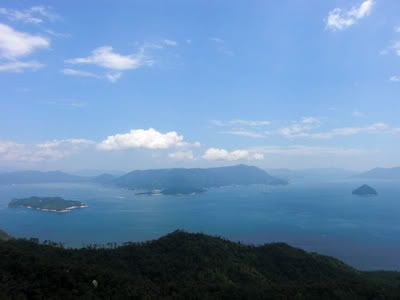
A notice at the cable car station mention that Mt Misen is a monkey kingdom. There are lots of monkeys hanging around the cable car station.

From the cable car station is another 100m climb or 20 mins climb up to the peak. At the halfway point is the Misenhondo Hall, where Kukai is said to teach here. Coincidentally at this time, it started raining, so I took refuge at the temple. After the rain, a fog envelope the mountain, giving it a mystical feel.

In the Reikado Hall which is directly opposite the teaching hall, it is said to contain the flame that has been burning for more than a thousand years. While helping an elderly japanese couple with the pot cover, I noticed warm water is being heated in there where visitors can have a seep. So I also tried it, it taste nice - natural mountain water. It is also this flame that is being used to light the flame of peace in Hiroshima peace park.
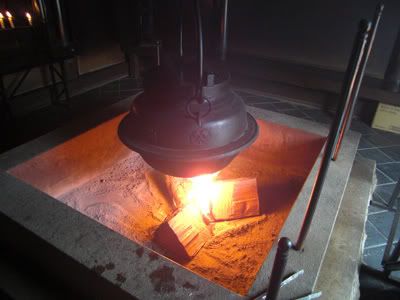
The rain stopped after 30mins and I continued my way to the peak. This is the picturesque scene. The clouds are below the peak and are flowing through like sea of clouds. It is really a fabulous sight.
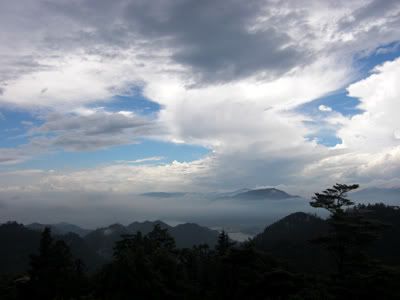
Here is me at the peak. An accomplishment.
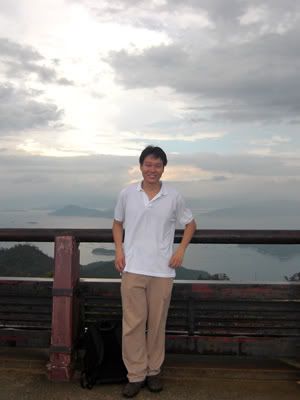
Thankfully I bought the 2-day free pass, so I took the cablecar back down to the foot of the mountain. Climbing the 100m mountain top is already somewhat exhausting. I have read other visitors blog who attempted to climb the 530m mountain and were completely KO by the time they reached the top. It also rained, thus mountain climbing is definitely out. Maybe the spring or autumn season will be a better time to attempt it.
Kangensai Festival
When I got down from the mountain top, the sea which I saw in the morning was gone. It is now low-tide and the mega torii gate is exposed. Hordes of people are walking around the gates for photoshot.
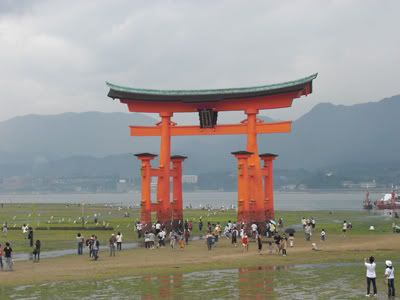
I made a quick detour to the city to catch the mega rice scoop. Miyajima is famous for its wooden rice scoop.
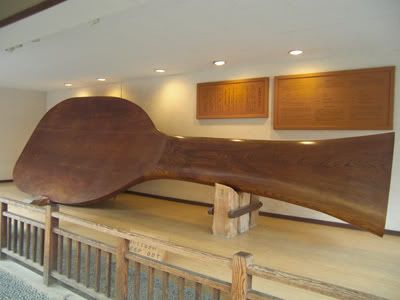
It is now back to Itsukushima shrine. If you compare this photo with a previous one taken above, you can notice the difference between high tide and low tide.
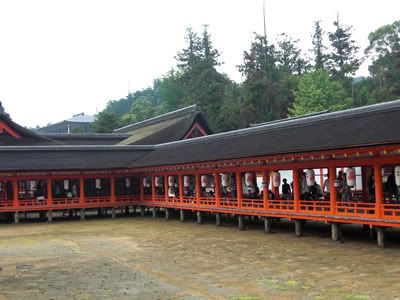
The festival ritual started in 4pm. It started raining rather heavily at this time. Thankfully the ritual is held indoors, thus I can just sit and observe the ceremony. By around 5pm, they are getting ready to move the portable shrine to the boats that have been moved out early this morning.
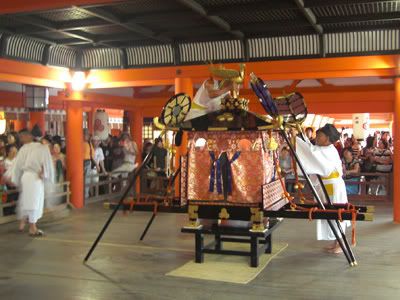
When they started moving out, the rain has yet to stop. The portable shrine and kids are covered with rain coats. But I am confident the rain is going to stop soon. Though it is still somewhat heavy. All I can say is that I believe in the combine karma of all the people and for the smooth running of this festival, the rain will stop soon. Thus I get ready to leave the shrine to catch a better glimpse of the proceedings.
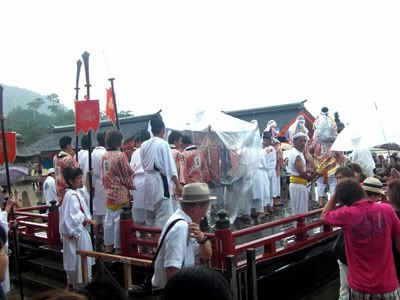
Eventually the rain really stopped! This is an amazing sight. A long line of people walking through the torii gate to the boat waiting at the sea. It is almost divine. The sun pierce through the clouds onto the land below. Green sea grass covered the entire land against the distant sea. The people are marching out with religious conviction (or curiousity). I took many pictures of this scene and really can't take my eyes off it. It is similar to the sight I saw in Nara of Todaiji: heavenly, divine, amazing.

I started to make a move at 5.40pm as the boats are departing. I noticed many Kaki (Oyster) stores in the Miyajima street. As I have not drank much water today, I think it is best for me to avoid such exotic food. Oyster is also not my favourite (I went for a buffet once in Singapore and they were having Oysters, I only took one and that's all).
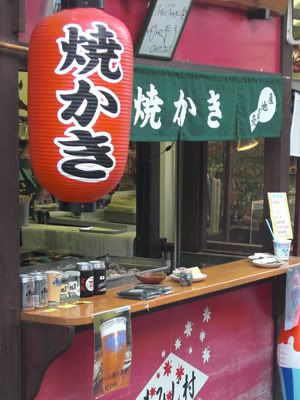
I took the 6.15pm ferry from the terminal. Coincidentally, it passes by the Kangensai boats. People pay 10,000+ Yen just to follow along the Kangensai boats in the sea. For me, it is just perfect timing when my ferry passes by them. It is close to sundown, so I took a closeup photo of the boats when my ferry travelled past them.

Jizozen Shrine
The boats are scheduled to arrive at Jizozen shrine (地御前) at 7.50pm. After a quick dinner of Soba at Miyajima-guchi, I took the tram to the Jizozen shrine which is 6mins away. There are already hordes of people around the shrine when I arrived at 7.20pm. Here is the twilight view of the scene in front of Jizozen shrine.
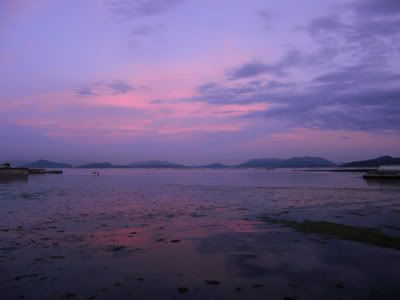
The shrine has lots of shops selling food and people are dancing in the shrine. It reminds me of the traditional tibetan dance which I have seen before. Even the dance rhythm feels similar.
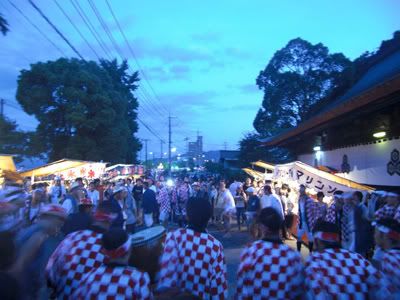
The video of the dance is captured below
The Kangensai boats have finally arrived. I noticed there are two fires burning on the main shrine boat. It is fantastic on how they have it under control in a wooden boat.
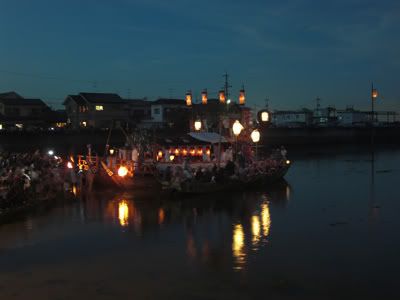 I left around 8pm for my accommodation.
I left around 8pm for my accommodation.




































































